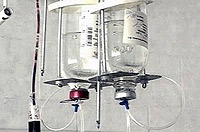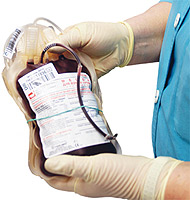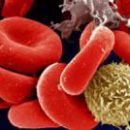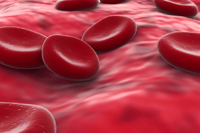The main method of treating acute leukemia is chemotherapy. Choice of chemotherapy scheme depends on leukemia subtype.
Content
Methods for the treatment of sharp leukemia in adults
Acute leukemia in adults is not one disease, but several, and patients with different leukemia subtypes are not identical to treatment.
The choice of therapy is based on both the specific subtype of leukemia and on certain characteristics of the disease, which are called prognostic signs. These signs include: the age of the patient, the number of leukocytes, the answer to chemotherapy and information about whether this patient was treated for another tumor.
Chemotherapy
Under chemotherapy implies the use of drugs destroying tumor cells. Usually antitumor drugs are prescribed intravenously or inside (through the mouth). As soon as the drug enters the bloodstream, it is distributed throughout the body. Chemotherapy - the main method of treatment of sharp leukemia.
Chemotherapy of acute lymphoblastic leukemia (All)
 Induction. The goal of treatment at this stage is to destroy the maximum number of leukemic cells for the minimum period of time and the achievement of remission (absence of signs of the disease).
Induction. The goal of treatment at this stage is to destroy the maximum number of leukemic cells for the minimum period of time and the achievement of remission (absence of signs of the disease).
Consolidation. The task at this stage of treatment is the destruction of those tumor cells that remained after the first ethip - induction.
Supporting therapy. After the first two stages of chemotherapy in the body, leukemia cells can still remain. At this stage of treatment, low doses of chemotherapy drugs are prescribed for two years.
Treatment of the lesion of the central nervous system (CNS). Due to the fact that acute lymphoblastic leukemia often applies to the shells of the head and spinal cord, the chemotherapy products in the spinal channel are imposed in patients or radiation therapy on the brain is prescribed.
Chemotherapy of acute myeloid leukemia (IML)
OML treatment consists of two phases: induction of remission and therapy after remission.
During the first phase, most of the normal and leukemic bone marrow cells are destroyed. The duration of this phase is usually one week. During this period, during the next few weeks, the number of leukocytes will be very low and therefore measures will be required against possible complications. If, as a result of weekly chemotherapy, remission will not be achieved, then re-courses of treatment are appointed.
The purpose of the second phase is the destruction of the remaining leukemic cells. Treatment during the week is then accompanied by a bone marrow recovery period (2-3 weeks), then chemotherapy courses continue several times.
Some patients prescribe chemotherapy with very high doses of drugs to destroy all bone marrow cells, after which stem cell transplantation is carried out.
Side effects of chemotherapy
In the process of destroying leukemic cells, normal cells are damaged, which, along with tumor cells, also have rapid growth..
Bone marrow cells, oral mucosa and intestines, as well as hair follicles differ rapid growth and therefore are exposed to chemotherapy. Therefore, patients receiving chemotherapy have an increased risk of infection (due to the low number of leukocytes), bleeding (low platelet) and increased fatigue (low number of erythrocytes). Other side effects of chemotherapy include: temporary baldness, nausea, vomiting and loss of appetite.
These side effects usually pass shortly after the cessation of chemotherapy. As a rule, there are methods to combat side effects. For example, anti-chemotherapy are prescribed to prevent nausea and vomiting together with chemotherapy. To increase the number of leukocytes and the prevention of infection, cell growth factors are used.
You can reduce the risk of infectious complications by restricting contact with microbes by careful hand processing, eating specially cooked fruits and vegetables. Patients receiving treatment should avoid clusters of people and patients with infection.
During chemotherapy, severe antibiotics may be assigned to patients for additional prevention of infection. Antibiotics can be applied at the first signs of infection or even earlier in order to prevent infection. With a decrease in the number of platelets, it is possible to transfusion, as well as the transfusion of erythrocytes with a decrease and the occurrence of shortness of breath or increased fatigue.
Lysis Tumor Syndrome - a side effect caused by the rapid decay of leukemia cells. With the death of tumor cells, they release in blood flow substances, damaging buds, heart and CNS. Purpose of a large amount of liquid and special preparations will help prevent the development of severe complications.
In some patients with all, after the end of treatment, other types of malignant tumors may occur later: Oml, Non-Hodgkin Lymphoma (Lymphosarcoma) or DR.
Stem cell transplantation (TSK)
Chemotherapy damages both tumor and normal cells. Stem cell transplantation allows doctors to use high doses of antitumor drugs in order to increase the effectiveness of treatment. And although antitumor drugs destroy the sick bone marrow, transplanted stem cells helps to restore bone marrow cells, producing blood cells.
 Stem cells are closed from bone marrow or peripheral blood. Such cells are obtained both from the patient and from the selected donor. Patients with leukemia are most often used donor cells, since tumor cells may be in the bone marrow or peripheral blood.
Stem cells are closed from bone marrow or peripheral blood. Such cells are obtained both from the patient and from the selected donor. Patients with leukemia are most often used donor cells, since tumor cells may be in the bone marrow or peripheral blood.
The patient is prescribed chemotherapy with very high doses of drugs for the destruction of tumor cells. In addition to this, radiation therapy is carried out to destroy the remaining leukemic cells. After such treatment, the preserved stem cells are entered by a patient in the form of blood transfusion. Gradually, transplanted stem cells are pressed in the bone marrow of the patient and begin to produce blood cells.
Patients who have transplanted donor cells are prescribed preparations that prevent the rejection of these cells, as well as other drugs for the prevention of infections. 2-3 weeks after transplantation of stem cells, they begin to produce leukocytes, then platelets, and in the end - red blood cells.
Patients who have been held TCK should be protected from infection (located in isolation) to the required increase in the number of leukocytes. Such patients are in the hospital until the number of leukocytes is about 1000 per cube. MM blood. Then almost every day such patients are observed in the clinic for several weeks.
Stem cell transplantation still remains a new and complex treatment method. Therefore, such a procedure should be carried out in specialized departments with specially trained personnel.
Side Effects for Stem Cell Transplants
TSC side effects are divided into early and late. Early side effects differ little from complications in patients receiving chemotherapy with high doses of antitumor drugs. They are caused by damage to the bone marrow and other fast-growing tissues of the body.
Side effects may exist for a long time, at times after transferred transplantation. From the late side effects it should be noted as follows:
- Radiation damage to the lungs, leading to shortness of breath;
- Reaction "Transplant against host" (RTPH), which occurs only when transplanting cells from the donor. This serious complication is observed when the cells of the immune donor system attack the skin, the liver, the oral mucous membrane and other organs of the patient. It is observed: weakness, increased fatigue, dry mouth, rash, infection and muscle pain;
- Damage to the ovaries, leading to infertility and impaired menstrual cycle;
- Damage to the thyroid gland causing disruption of metabolism;
- Cataract (damage to the lens of the eye);
- Bone damage; In severe changes, it may be necessary to replace the part of the bone or joint.
Radiation therapy
Radiation therapy (use of high-energy X-rays) plays a limited role in the treatment of patients with leukose.
In adult patients with acute leukemia, irradiation can be applied with the defeat of the central nervous system or testicles. In rare emergency cases, radiation therapy is prescribed to remove the trachea to the tumor process. But even in this case, chemotherapy is often used instead of radiation therapy.
Operational treatment
In the treatment of patients with leukemia, in contrast to other types of malignant tumors, the operation is usually not used. Leukemia - blood illness and bone marrow and it is impossible to heal surgically.
In the process of treatment with patient leukemia with a small surgery, a catheter can be introduced into a large vein for the introduction of antitumor and other drugs, blood takes for research.
What happens after the treatment of sharp leukemia
After the treatment is completed for acute leukemia, dynamic observation in the clinic is necessary. Such a surveillance is very important, as it allows the doctor to observe a possible recurrence (refund) of the disease, as well as for the side effects of therapy. It is important to immediately inform the doctor about the symptoms.
Usually the recurrence of acute leukemia, if it happens, occurs during treatment or shortly after its end. Recurrement develops very rarely after remission, the duration of which exceeds five years.









